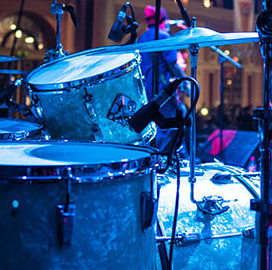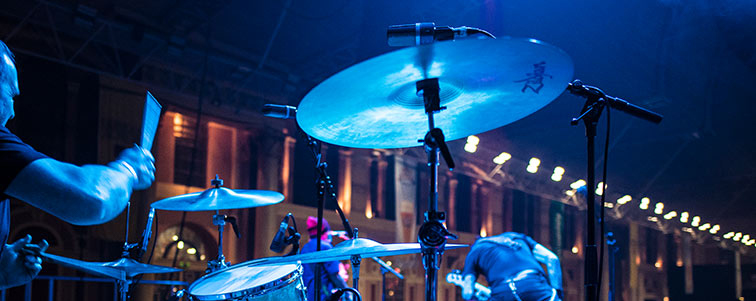Drum Tracking [the basics you need to know]
What is drum tracking? Basically it’s another way of saying drum recording. It’s the process of turning your drum audio into tracks. So whether you’re drum backtracking in the studio or online tracking via you’re bedroom, it’s still drum recording. In this post I’ll show you the basics to get you off to a good start.
What Do You Need for Drum Tracking [Online/Drum Backtracking]
So what do you need for basic drum tracking? You’ll need:
- A full drum kit
- Somewhere to record them (especially for online drum tracking)
- A set of Microphones
- XLR / microphone leads
- Stands
- A computer with DAW software
- An interface
- Headphones / In Ear Monitors (IEM)
There are many variables to drum tracking such as; the player you are, the style of music you’ll be recording, the choice of drum kit and cymbals, the room you’ll be in, the microphones you use and so-on. Therefore if you start with the above equipment list you’ll have a good start for when it comes time to record.
If you check out my 2 Mic Drum Recording, you’ll see I drum tracked at a London rehearsal studio with only; an interface, a computer, a couple of mics and my cymbals. The rest of the equipment was provided by the studio (drums, leads et al.). Because the room is already soundproofed, I managed to get a decent drum sound with limited equipment.
So don’t worry if you don’t have all the items on the list or your own studio just yet. Start with what you can and work your way up from there.
Tune Your Drums
Whenever you’re drum backtracking you need to make sure your drum kit is at its best. That means making sure it’s nicely in tune and all those unwanted noises are dealt with. Such as overtones controlled or excessive ringing dampened. This will depend on the style of music you’ll be drum tracking along with as to the type of tuning you need.
Even a beaten-up, old drum kit can sound pretty good with the right tuning. It helps having new drum heads but it’s not necessary – unless the head is broken or used beyond recognition.
Setting Up
Setting up your recording equipment couldn’t be easier. Firstly, get your drums set up (and tuned) then start adding the mics. On my session in the video above I used these microphones –
- Beta 52A – External bass drum / kick mic
- Audix D6 – Internal bass drum / kick mic
- E604 (x2) – For the toms
- SM57 (x2) – For the over and underside of the snare
- Blue Cardioid Condenser (x2) – The Overhead Mics
Most of these mic’s are industry standard. If you don’t have the budget for these types of mics, start with what you can. For example, use the microphones at your local rehearsal studio (mics may even come included with the room). The idea is to get familiar with the recording process.
Mic Placement With Drum Backtracking
Mic placement is obviously important when drum backtracking / tracking. For example, if you have a two mic recording set up (one dynamic mic and one condenser mic), a good start would be to have the dynamic mic in front of the drums and the condenser above the drums.
The more microphones you have, the more control over the overall sound. Generally speaking you place your microphones above each instrument (drum) an inch or two away from the drum head – above the rim of the drum or inside a drum like the bass drum. Obviously the overhead mics or room mics which you want to set up a further distance from the drums. Furthermore, the close mics should point towards the centre of the drum. This will depend of what type of sound you’re after so don’t be afraid to experiment with different placements.
The proximity of the mics from the drums will play a huge part too. Inevitably the closer you place the mics to the sound source the tighter and more direct the sound will be. The further away you place the mic the more roomier / ambient the sound will be.


Furthermore, phasing or polarity issues can occur with certain microphone placement. This means that the sound waves / wave forms from the source reach the microphones at slightly different times due to the distance or placement. Likewise, if 2 mics are on one instrument; such as the over and underside of a snare drum. One mic will have the sound moving away from it and the other will have the sound moving towards it. For more in-depth knowledge on this issue read more here.
Plug In And Get Levels
Next you’ll want to plug your mics into your interface and start getting some mic levels. Your choice of interface will determine the quality of your preamps; the preamps effectively add gain to the mic level signal.
Ideally you want the levels to be peaking around the -10db to -6db mark. This will enable you to have some headroom should you need it. You don’t want the levels to be peaking into the red from the off.
Online Drum Tracking – Raw Files
You may find the artists or producers that hire you for online drum backtracking / tracking may only require the raw drum files / tracks. This is due, in part, to them wanting to process the drum stems (group of drum tracks) themselves.
Obviously it’s difficult to mix drums without the track reference anyway. Furthermore your idea of what the drums should sound like may be different to theirs. So if this is indeed the case, you don’t need to do much other than record the drums onto your DAW (with good levels of course) and then simply export the files.
Overdubbing Or Drum Backtracking?
Now technically, if you add drum tracks (or any other tracks for that matter) onto an already established tracked piece of music – like the one in my drum tracking video – it’s regarded as overdubbing. So when you start with the drum tracking, you are actually laying down the backing tracks or drum backtracking.
Have Your Say
Have your say in the comments section below. Is there anything I missed out or you think could be added? Let me know in the comments section below.
Otherwise, I hope this helps with your understand of drum tracking / drum backtracking or online drum tracking!
